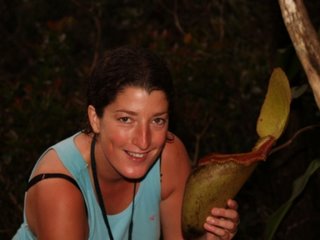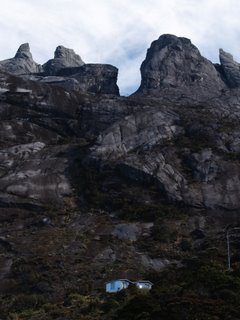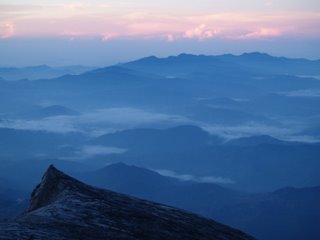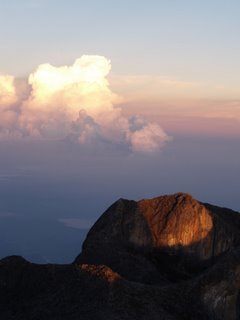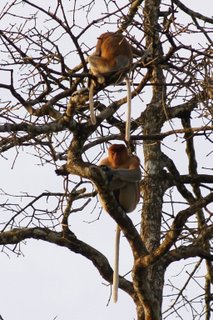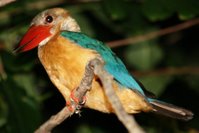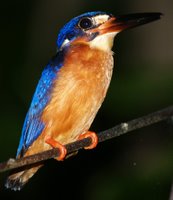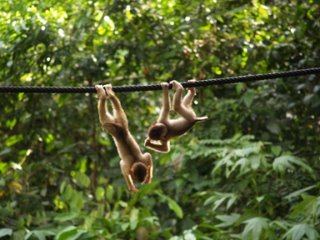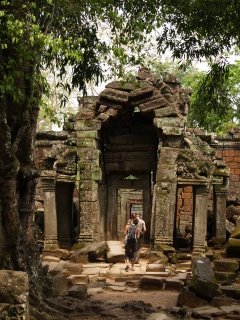Borneo - Mount Kinabalu
Our final challenge in Borneo was to climb to the summit of Mount Kinabalu, which is SE Asia's highest mountain and half the height of Everest. It is fair to say that we could have been a little better prepared physically and I don't think that either of us really knew what we had let ourselves in for.
The guide book had suggested that we could just turn up and climb the mountain but on arrival, but it became obvious that this was not the case. The walk was to take two days, so you had to book accommodation in a hut that was 3/4 of the way to the top. Unfortunately, the huts were all full, so we put our name of a waiting list in the hope that two people would not turn up. To cut a very long story short, we arrived at the national park's HQ on the morning we planned to walk and waited around for hours, believing that there was little hope that we were going to be able to walk. I would have been really disappointed but Catherine had already set her sights on spending the day at the natural spa resort that was close by! Just before the cur off point that we would have been allowed to set off to climb, we were informed that we, along with another couple from Belgium - Ann and Pieter, who were on their honeymoon! - were informed that we could do the climb, so we set off together.
The climb started well, as we bumped into Will and Gill who we had met at the Borneo Rainforest Lodge and were very pleased to see. We had only been walking for about an hour and were still feeling fairly fresh. They were in the national park to do a bit of bird watching and see the pitcher plants, which Will had told us all about.
Catherine and I, with Will and Gill - only an hour into the walk!
Pitcher plants are carnivorous and there are 40 species that can be found in Borneo, with many of these being found in the Kinabalu National Park. After a brief synopsis from Will we were keen to see some, so asked our guide to show us a few examples along the way. The largest was to be found a short detour of the main track and was a formidable sight. The plants have sticky leaves, quick closing traps or slippery pitchers that they use to catch insects, before digesting them to get the precious nutrients.
We were only carrying day packs for the climb and packed them full with energy snacks and chocolate to keep us going. The first day's walk was about 4 hours and was pretty steep but not too bad. The air was heavy and humid and the view was obscured by a thick layer of mist. A couple of hours in, there was a tropical downpour and we were to stay drenched for the next 2 days! Our camp for the first night came as a welcome sight, despite the lack of comfort - the huts were very basic, with a few bunk beds and an outside toilet. There was however, a small restaurant that served a buffet, so we tucked in and ate as much as we could - I think that's the point of buffets anyway, isn't it?! It was early to bed as we were to be up at 2.30am to get to the top before the sunrise. The night was very cold but with a sleeping bag and a ton of blankets, we managed to get some sleep, although we were both very nervous about what lay in store for us the next day.
Our hut and still a lot of climbing to be done
We had a small breakfast and set off at 3am with the aim of getting to the top before 6.30am. The rain had cleared and the sky was beautiful, with no light pollution to spoil the night's incredible display of stars. The only light was the small but steady procession of torch dots that led a path to the top. The climb appeared to be hard for almost everybody, especially as the top drew closer. Exhausted bodies were collapsed on the side of the route as people tried to summon up the strength to take a few more steps. It was a very strange experience, with very little noise and almost no communication between walkers. The landscape was so barren, as almost no vegetation is able to survive at that altitude, so it felt as though we had been transported to a silent and rock covered planet that was far away from earth.
On many of the walks that we have done before, I have been the one encouraging Catherine to keep going but this was to be the exception. The air felt very thin and I really struggled with the altitude, which effected my body for the remainder of the climb. I felt overcome by sickness and completely sapped of all my energy and strength. It is without doubt the toughest thing that I have ever done and there were many occasions when I thought that I could not take another step, even when the top was in sight and only a few hundred metres away. Catherine seemed to have more strength than me and tried to keep us both going, although I'm not sure that I appreciated all of her encouraging and positive words!
Battling on through adversity!
When we finally reached the top, I think that the most overwhelming emotion was relief. It took quite some time before the exhilaration of achievement or any appreciation of the incredible views became possible. It was very, very tough but we still made it to the top in time for the sunrise.
Above the clouds - the view from the top as dawn broke
Finally we made it down but our joints seized up and we were stuck in this pose for a week!
Borneo - Jungle Camp
Laura hanging out at the camp
The Kinabatangan Jungle Camp was not part of our original Borneo itinerary. Various people at the Rain forest lodge recommended it to us, so we thought we would check it out.
It was not nearly as luxurious as the lodge and we were the only people staying but we soon realised why so many people had recommended it. Our stay consisted of morning, afternoon and evening river cruises on the Kinatbatangan river with our guide who's name we couldn't understand or pronounce and after a few hours of trying we gave up - we will call him Bob for the benefit of this blog! Unfortunately, Bob did not have a good grasp of English and he didn't understand our questions so he gave us limited information. However, he was an excellent spotter and there was loads to see.
We saw loads of Proboscis monkeys relaxing at sunrise or swinging through the trees. The proboscis monkeys are only found in Borneo and due to a reduction in their habitat and hunting, there are only about 7000 left in the wild, so it was a privilege to see them.
A sly croc on the bank!
The long tailed macaques were a very common sight along the river. They fed on buds, fruits, insects, spiders and cereals but the best site was watching them hunt for river crabs. They hung their tail in the water like a fishing line and waited until an unsuspecting crab grabbed hold. The monkey quickly whipped its tail out of the water, grabbed the crab and starts crunching, mmm! However, we drifted a bit to close to one of the monkeys who proceeded to hop onto a branch above us and then to urinate on me. It was a disgustingly fowl smell that seemed to linger on my arm for the next two days, very pleasant!

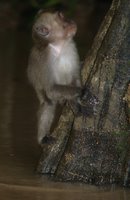
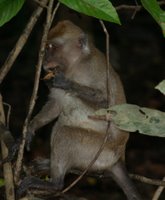
A Long tailed Macaque fishing and crunching on a fresh water crab
In the evening we went on a night cruise. We were not sure what animals could possibly be spotted from a boat in the pitch dark, with a torch, but our guide didn't let us down. We were amazed by his ability to spot wildlife both in the daylight and in the pitch black of the night. We were joined by another guide who held the torch while Bob kept a look out. We saw loads of animals and birds and it was very exciting. However, it stated to rain and Bob dived for cover under the seat, covered himself with life jackets and took shelter whilst were sat in our seats with no waterproofs, getting soaked. Then, to top it off, the one and only torch suddenly went out. The boys preceded to try and mend it by the light from my camera flash and a lighter that was situated dangerously close to the petrol can. It was a bit hairy floating down the river in the pitch dark with ominous noises coming from the undergrowth and the thought of crocodiles swimming close by. Thank goodness the boys managed to fix the light and we were off again for more spotting. Below are some more pics of our night cruise, which turned out to be a great adventure.
The boys at work fixing the torch
A Buffy Fish Owl, A Stork Kingfisher, Blue-eared Kingfisher
The whole trip was excellent. It was a totally different experience from the Rain forest Lodge but just as enjoyable.
Borneo - Sepilok Orangutan Sanctuary
We ventured to the Sepilok Orangutan Sanctuary to get a better look at the orangutans, even if they were not exactly wild. The sanctuary is supposedly one of the best places in the world for orangutans and was set up to look after sick, injured or orphaned animals. The animals are kept in a semi-wild environment but are fed twice a day. The sanctuary aims to rehabilitate the animals, teach the orphans the skills they need to survive and then release them back into the wild.
The flight from one side of Borneo to the other was mostly over palm oil plantations and it showed us how much of the orangutan's natural habitat has been destroyed. Decades ago, the native forest was cut down to make way for a series of cash crops, the most recent being palm oil plantations. We were told that the illegal logging was now under control in most areas but it was still shocking to see such destruction and showed why that the orangutans, along with many other animals, are critically endangered.
We watched the organtans for both of the feeding sessions and they made for compulsive viewing. In the morning it poured down and even the animals seemed depressed but in the afternoon, it was glorious and we both loved it. They were also great to photograph, so obviously I was happy - they even seemed to pose for the camera.
Mother and baby feeding on sugar cane
Borneo - The Borneo Rainforest Lodge
We arrived in Borneo and were picked up at Lahad Datu Airport ready to be taken into the Borneo Rainforest. We were both very excited but after a two hour journey down the bumpiest of logging tracks, we were glad to arrive. We were greeted with a welcome drink, Benidorm style with a paper umbrella and sparkly things. It was quite bazaar drinking such a cocktail in the middle of the rain forest but the whole place was a little bit of luxury in the jungle! The Lodge was the only visitor accommodation in the Danum Valley so we felt privileged to be part of a small group of people staying in such a wonderful place.
A view of the Lodge from the hillside
Our time at the lodge consisted of a variety of walks - under the excellent supervision of William our personal guide for 3 days - where we encountered lots of weird and wonderful flora and forna. We were kitted out in bright green leech socks, as advised by William and after I was almost eaten alive by leeches in the tea plantations in Sri Lanka, I was taking no chances. There were many tracks and trails and you never knew what you would come across next. The lodge had a canopy walkway which was 31 metres high and 37 metres long. It was a bit rickety and it swayed quite a bit but I was surprisingly confident, I think it was just the excitement of what we would see next.
Holding on tight to the canopy walkway (sporting our leech socks!) and with William our guide
On our first morning, we woke at 5.45am and were greeted by a dawn chorus of birds and animals. The most impressive and my favourite were the gibbons who made a loud call to wake up their mates. They were far away in the distance but they could be heard for miles. We were very excited and got ready for our first walk. The main reason for my visit to Borneo was to hopefully see the orangutans, although after investigation, I realised that the probability of seeing an orangutan in the wild was slim to none. Nonetheless, we were up in the canopy, when one of the guides said that he had seen some movement in the trees ahead. To our surprise and amazement, there were four orangutans having their breakfast in a fig tree. It totally took my breathe away. We were about 200 metres away and although the trees were quite dense we got a good look at them . If I didn't see anything else at my time at the lodge, I would leave happy.
Pregnant Bornean Orangutan in a fig tree
In the afternoon, we went on another walk and were lucky enough to see another three Orangutans - twice in one day! In the evening we were treated to a night drive, so were met by a huge truck, a guide and an enormous search light that lit up the trees. The truck was so large and so noisy that any creature in a three mile radius would run for cover! We were a bit dubious about what we would see but it was good fun and we did spot some eyes in a tree, which was apparently a flying squirrel!
On the second day, we were returning to the lodge for lunch - a culinary delight - when we saw some people peering up into the trees. They we looking at a group of red leaf monkeys that were jumping across an 8 metre gap from from tree to tree, 20m above our heads. Laura got a great photo, which she is very proud of and shows it off on every possible occasion!
Red leaf monkey in mid flight, with a baby attached to the mum's tummy
While staring at the monkeys we met Will and Gill, who were a couple from Texas and almost as enthusiastic and excited to be at the lodge as we were . They spent at least one month a year being guides in Brazil so they were very knowledgeable about the wildlife in the rainforest. Carolyn and Mike were the other couple in our group and they were also absolutely lovely. There was so much going on all the time that we spent a lot of time feeling exhausted, although I found a perfect spot for an afternoon snooze!
Just a quick power nap before dinner!
We were lucky enough to see at least one orangutan every day but the last morning proved to be the best and most memorable. As usual, we were woken by the sound of a gibbon but on this day, the noise was much louder. I stepped out onto our balcony and saw two people scurrying along the path with cameras and binoculars in hand, so we quickly followed. A gibbon treated us to quite a display, as it called out and then swung through the trees right outside our room.
On our final morning walk, William took us to where a orangutans nest had been spotted the previous day - Orangutans make a new nest every day. The nest was empty when we arrived but we were startled by a mother and baby orangutan just off the path. We were obviously too close as the mother made a loud kissing sound to show us her displeasure and warn us off, before climbing up the tree to safety. I have never and may never again get that close to such an amazing wild animal. This sighting was certainly a highlight and I felt incredibly privileged, as the hairs on the back on my neck stood up. Before returning to the lodge for breakfast, we also spotted a group of long tailed macaque monkeys, some red leaf monkeys and an Argus pheasant, which are the largest of all the pheasants and made the 'birders' - as the bird watchers call themselves - very jealous. As a result, they quickly picked up their binoculars, fumbled for their note books, sharpened their pencils and sprinted in the direction of the poor pheasant - it was soon be surrounded by eager twitchers!
What are we looking at??
Unfortunately, our time had to come to an end and we were very sad to be leaving. I have never experienced anything like this and I loved every minute of it. The lodge was lovely, the food was delicious and the people we met, made the trip. It was the whole package and of course the orangutans that made this an unforgettable experience.
Some more photos from the Lodge
Helmeted Hornbill flying overhead
Rhinoceros Beetle that Laura made me put my hand next to.
A Tree Nymph or Paper Butterfly - They were really beautiful and became almost invisible in the sunlight
Cambodia
Cambodia was an experience. We spent only 10 days in the country and managed stops at the two main tourist destinations, Phnom Pehn and Siem Reap (the temples of Angkor).
The capital Phnom Pehn was quite an attractive city in parts but you only had to turn a corner to see devastating poverty or feel a little threatened for your own safety. The country has an extremely violent past, which never felt that far away. For me, this feeling was reinforced by the billboard posters that attempted to encourage a better future with the slogan "We no longer need guns".
The most moving day of our trip was the day we visited the Killing Fields and S21, a junior school, which became a Khmer Rouge prison and interrogation/torture centre. Thousands of people were viciously murdered at the killing fields and were buried in mass graves. In the 1980s - a decade later - the graves were dug up and the skulls were placed in a large glass tower, to commemorate those who died there. The skulls were labelled according to age and sex and ranged from children to elderly people. It was certainly a horrific sight and one which I will never forget.
Skulls in the Killing Fields
The afternoon was spent at the former prison, which is now a very effective museum. The displays were simple and powerful and the place was eerily silent, despite the number of people that were visiting. The former classrooms were now used to display black and white photographs of all those who were imprisoned - most of whom were later killed. The exhibits told the varied stories of the people who lost their lives during the Khmer Rouge regime.Our second spot in Cambodia was Siem Reap, where we spent a couple of days exploring the Temples of Angkor. We hired a lovely driver for two days and he took us around to visit the sites, as well as giving us a bit of history about each of the temples. We bought a 3 day entrance ticket and packed our days with exploring but there were so many to see that plenty more lay undiscovered to our eyes.
Catherine, our driver, Sotera and his tuk tuk
Posing monk
The most famous of the temples is Angkor Wat and it appears on absolutely everything in Cambodia from T-shirts to banknotes, so when we did actually see it, I already felt as though I'd seen it before. It was however, the most popular for good reason. It is very well preserved compared to many of the demolished piles of rocks that make up some of the other temples and is a formidable construction from all angles. The best way to enjoy and experience all of the temples was to find somewhere quiet and just reflect on them for a while, in an attempt to take it their vastness and magnitude. Unfortunately, this was impossible at Angkor Wat, as there was a continuous procession of tour buses that piled through, behind a guide with an their umbrella in the air. Nonetheless, we managed to pose for the classic 'in front of Angkor Wat' picture and did manage to appreciate the temple in all its incredible glory.

